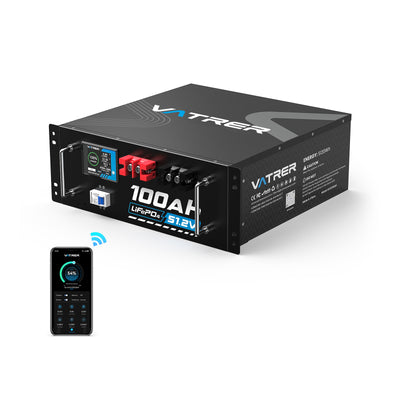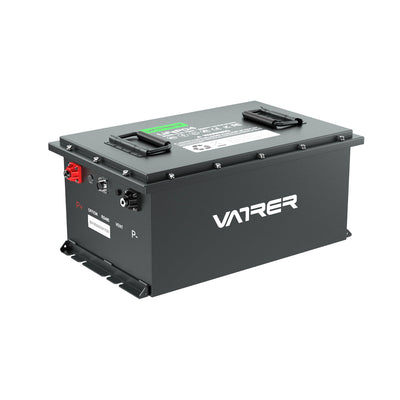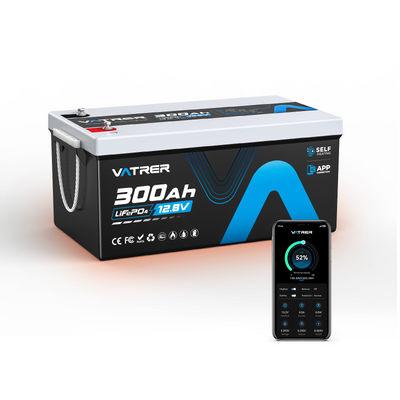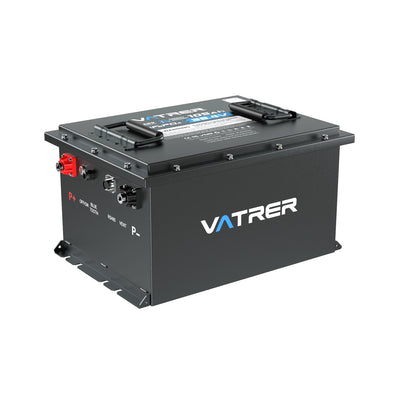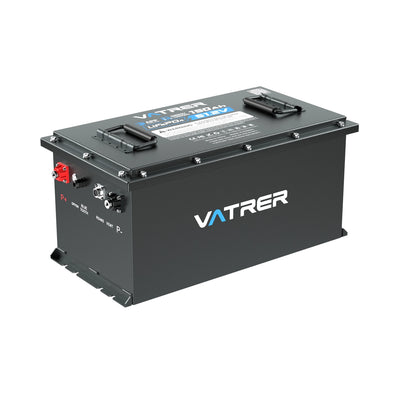RV Battery Winter Storage Comprehensive Guide
Reading time 6 minutes
As temperatures begin to fall, many RV owners prepare their rigs for winter by draining plumbing lines, sealing windows, and covering tires. Yet one important task is often missed: properly storing the RV battery.
Cold weather doesn’t just slow the vehicle—it directly affects how a battery behaves. Low temperatures alter internal chemistry, which can lead to frozen electrolytes, reduced performance, and even long-term damage. If ignored, an RV battery may fail before spring arrives, resulting in costly replacements and unexpected downtime.
This guide explains how to store your RV batteries correctly, protect them from freezing conditions, and maintain a healthy power system—whether your RV will be parked for the season or used in colder Canadian climates.

How Cold Weather Affects RV Batteries
Cold conditions influence each battery chemistry differently. When temperatures drop:
- Electrochemical activity slows down, lowering voltage output and making charging less efficient.
- Batteries continue to self-discharge, and cold weather accelerates the loss of available power.
- Flooded lead-acid units may freeze if not fully charged, potentially causing internal fractures.
- Lithium RV batteries (LiFePO4) will not accept a charge below 32°F due to built-in BMS protection.
- Staying deeply discharged over the winter can permanently reduce total capacity.
- Ideal storage range: between 40°F and 70°F in a dry, ventilated location.
Tips: If your RV remains outdoors, consider insulating the battery bay or storing the battery indoors to reduce exposure to freezing temperatures.
Identify Your RV Battery Type Before Storage
Different battery chemistries require different winter care. Knowing your battery type helps you apply the correct maintenance steps and avoid unintended damage.
| Battery Type | Winter Risks | Best Storage Tips |
|---|---|---|
| Flooded Lead-Acid Batteries | Freezing, sulfation, water loss | Maintain full charge, verify electrolyte levels, add distilled water, store above freezing in a dry area |
| AGM (Absorbed Glass Mat) | Gradual loss of capacity | Store fully charged, check voltage monthly, use a smart maintainer or trickle charger |
| Gel Cell | Sensitive to heat and overcharging | Avoid high temperatures, inspect voltage often, store where conditions remain stable |
| LiFePO4 Lithium RV Battery | Charging restricted below freezing | Store at 40–60% charge, use a heated battery enclosure or a self-warming lithium option |
Pro Tips: Modern self-heating lithium RV batteries, including Vatrer’s advanced LiFePO4 lineup, warm themselves before charging, making them safe to use in sub-zero conditions.
Key First Steps RV Battery Before Winterizing
Before storing your RV for the winter, follow these important steps to protect the battery and simplify spring setup.
a. Fully Charge or Partially Charge the Battery
Charge lead-acid batteries to 100% before storage to prevent sulfation and freezing.
For lithium RV batteries, keep them at roughly 40–60% charge to reduce long-term stress.
b. Disconnect the Battery
Turn off the RV’s master disconnect and remove the negative cable first, then the positive.
This prevents slow power drains from detectors, control boards, and clocks.
c. Label or Photograph Cables
Take a picture before disconnecting wires to make reconnection simpler in spring.
d. Remove the Battery (If Possible)
In harsher winter regions, take the battery out and bring it indoors.
Store it in a dry, climate-controlled area such as a heated garage or basement.
Avoid setting it directly on concrete; use insulation or a wooden board to prevent moisture transfer.
e. Clean the Terminals
Use a wire brush to remove corrosion, then apply dielectric grease to guard against oxidation.
Lead-Acid Battery Storage Tips
Lead-acid batteries require the most attention during winter:
- Always store them fully charged, as a full battery resists freezing and sulfation.
- For flooded models, inspect electrolyte and top up with distilled water as needed.
- Keep the battery in a cool but non-freezing area, like a heated garage.
- Use a trickle charger or smart maintainer every few months to prevent discharge.
- Avoid sealed environments where hydrogen gas could accumulate.
Tips: If you notice white or green corrosion on terminals, clean it with a baking-soda-and-water mixture before applying grease.
Lithium Battery Storage Tips
Lithium RV batteries—especially LiFePO4—are easier to maintain but must be protected from extreme cold.
- Keep the battery at 40–60% charge, not full.
- Store between 50–68°F whenever possible and avoid long periods below freezing.
- Because lithium batteries self-discharge slowly, check them every few months and recharge if capacity drops below roughly 50%.
- If equipped with Bluetooth monitoring, use the app to review voltage remotely.
- For winter camping, consider an insulated battery enclosure or heating pad.
Tips: Never charge a lithium battery below freezing unless it has a built-in heating feature. Charging cold cells can cause irreversible plating damage.
Should You Leave the Battery in the RV or Remove It?
Your storage choice depends on climate and available power:
| Condition | Recommended Action | Notes |
|---|---|---|
| Very cold climate, no shore power | Remove the battery | Store indoors to prevent freezing |
| Moderate climate, shore power available | Leave in RV | Use a smart charger or maintainer |
| Variable conditions | Follow manufacturer’s BMS guidance | Check voltage monthly; keep above 12.4V (lead-acid) or 50% SOC (lithium) |
Tips: Even if the battery stays in the RV, check voltage, corrosion, and wiring periodically.
Monitoring and Maintenance During RV Battery Storage
Routine monitoring keeps RV batteries dependable through the winter. Maintenance varies depending on whether you use flooded lead-acid or lithium RV batteries.
| Battery Type | Charging During Storage | Voltage Check | Temperature Range | Special Care |
|---|---|---|---|---|
| Flooded / AGM Lead-Acid | Use maintainer or charge every 1–3 months | Every 4–6 weeks | Above 40°F | Monitor water levels, clean terminals |
| Lithium (LiFePO4) | No maintainer needed; recharge if below 13.0V | Every 2–3 months | 40°F–70°F | Maintain 40–60% charge, avoid freezing temperatures |
Tips: If lead-acid terminals develop residue, neutralize corrosion with baking soda and water before rinsing and drying. For lithium batteries, never attempt charging below 32°F unless the battery includes a heating feature.
RV Battery Troubleshooting After Winter
Before reinstalling the battery in spring, perform a quick assessment:
- Swollen case or cracking: discard immediately—likely freezing or overcharging damage.
- Corroded terminals: clean with baking soda solution and dry completely.
- Rapid voltage drop after charging: may indicate sulfation or cell aging.
- Strong sulphur smell: could signal a leak—replace right away.
- Weak startup: low output; test before relying on the battery.
Recommended Tools for Winter RV Battery Care
| Tool / Product | Purpose | Example Brands |
|---|---|---|
| Smart Battery Maintainer | Maintains voltage without overcharging | NOCO Genius, Victron Blue Smart |
| Battery Monitor | Tracks voltage, SOC, and temperature | Victron BMV |
| Insulated Battery Box | Protects from freezing and moisture | Camco |
| Heating Pad or Blanket | Keeps lithium batteries above charging temperature | Kat’s, Facon |
| Dielectric Grease | Prevents corrosion on terminals | CRC, Permatex |
Why Proper Storage Saves Money and Extends RV Battery Life
Correctly stored batteries can last twice as long as neglected ones. By preventing freeze damage, corrosion, and deep discharge, you reduce repair costs and avoid early replacements.
Keeping batteries at a steady charge level and maintaining stable temperatures helps protect both your electrical system and your overall investment in the RV.
Conclusion
Taking care of your RV battery through the winter is one of the most effective ways to preserve its lifespan. Whether you’re using traditional lead-acid batteries or switching to lithium RV power systems, the essentials remain the same: keep them charged, clean, and shielded from extreme cold.
Vatrer Battery provides advanced lithium RV batteries engineered for long-term durability, featuring smart BMS protection, low-temperature charging safeguards, and optional self-heating technology. These features simplify winter storage and ensure your battery is ready whenever you’re prepared to travel again.
Share


































